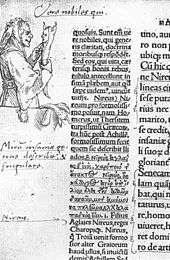In Praise of Folly

In Praise of Folly, also translated as The Praise of Folly, (Latin: Stultitiae Laus or Moriae Encomium (Greek title: Morias enkomion (Μωρίας ἐγκώμιον); Dutch title: Lof der Zotheid) is an essay written in Latin in 1509 by Desiderius Erasmus of Rotterdam and first printed in June 1511. Inspired by previous works of the Italian humanist Faustino Perisauli De Triumpho Stultitiae, it is a satirical attack on superstitions and other traditions of European society as well as on the Western Church.
Erasmus revised and extended his work, which was originally written in the space of a week while sojourning with Sir Thomas More at More's house in Bucklersbury in the City of London.[1] The title Moriae Encomium had a punning second meaning as In Praise of More. In Praise of Folly is considered one of the most notable works of the Renaissance and played an important role in the beginnings of the Protestant Reformation.[2]
Content
In Praise of Folly starts off with a satirical learned encomium, in which Folly praises herself, after the manner of the Greek satirist Lucian, whose work Erasmus and Sir Thomas More had recently translated into Latin, a piece of virtuoso foolery; it then takes a darker tone in a series of orations, as Folly praises self-deception and madness and moves to a satirical examination of pious but superstitious abuses of Catholic doctrine and corrupt practices in parts of the Roman Catholic Church—to which Erasmus was ever faithful—and the folly of pedants. Erasmus had recently returned disappointed from Rome, where he had turned down offers of advancement in the curia, and Folly increasingly takes on Erasmus' own chastising voice. The essay ends with a straightforward statement of Christian ideals. "No Man is wise at all Times, or is without his blind Side."

Erasmus was a good friend of More, with whom he shared a taste for dry humor and other intellectual pursuits. The title "Morias Encomium" can also be read as meaning "In praise of More". The double or triple meanings go on throughout the text.
The essay is filled with classical allusions delivered in a style typical of the learned humanists of the Renaissance. Folly parades as a goddess, offspring of Plutus, the god of wealth and a nymph, Freshness. She was nursed by two other nymphs, Inebriation and Ignorance. Her faithful companions include Philautia (self-love), Kolakia (flattery), Lethe (forgetfulness), Misoponia (laziness), Hedone (pleasure), Anoia (dementia), Tryphe (wantonness), and two gods, Komos (intemperance) and Nigretos Hypnos (heavy sleep). Folly praises herself endlessly, arguing that life would be dull and distasteful without her. Of earthly existence, Folly pompously states, "you'll find nothing frolic or fortunate that it owes not to me."
Reception
Moriae Encomium was hugely popular, to Erasmus' astonishment and sometimes his dismay. Even Erasmus' close friends had been initially skeptical and warned him of possible dangers to himself from thus attacking the established religion. Even Leo X and Cardinal Cisneros are said to have found it amusing.[3] Before Erasmus' death it had already passed into numerous editions and had been translated into Czech, French, and German. An English edition soon followed. It influenced the teaching of rhetoric during the later sixteenth century, and the art of adoxography or praise of worthless subjects became a popular exercise in Elizabethan grammar schools: see Charles O. McDonald, The Rhetoric of Tragedy (Amherst, 1966). A copy of the Basel edition of 1515/16 was illustrated with pen and ink drawings by Hans Holbein the Younger.[4] These are the most famous illustrations of In Praise of Folly.
Its role in the beginnings of the Protestant Reformation[2] stem from the foundation of critique which the essay laid against the practices of the Church and its political allies.[5]
Notes
- ↑ Bucklersbury was "A short street leading from the junction of Cheapside and Poultry to Walbrook. It barely exists today." source with map.
- 1 2 Janin, Hunt (2008). The University in Medieval Life, 1179–1499. McFarland. p. 160. "Although Erasmus himself would have denied it vehemently, later reformers found that In Praise of Folly had helped prepare the way for the Protestant Reformation."
- ↑ Collett, Stephen (1823). Relics of literature. Ludgate Hill, London: Thomas Boys.
- ↑ Wolf, 2004, p. 11
- ↑ Von Dehsen, Christian D., Scott L. Harris, eds. (1999). Philosophers and Religious Leaders; Volume 2 of Lives and legacies. Greenwood Publishing Group. p. 62.
External links
| Wikisource has original text related to this article: |
| Latin Wikisource has original text related to this article: |
| Wikiquote has quotations related to: In Praise of Folly |
- The Praise of Folly, translated by John Wilson in 1668, at Project Gutenberg
- Praise of Folly at Internet Archive (scanned books original editions)
- In Praise of Folly, English translation published in 1922.
- Subhasis Chattopadhyay, Review of the Princeton Edition of The Praise of Folly, Prabuddha Bharata, 121 (4) (April 2016): 429–31
- The Praise of Folly, English audiobook recording at LibriVox
- In Praise of Folly from Christian Classics Ethereal Library
- Desiderius Erasmus (1509). Praise of Folly. Published by Desiderius Erasmus. – via Google Books